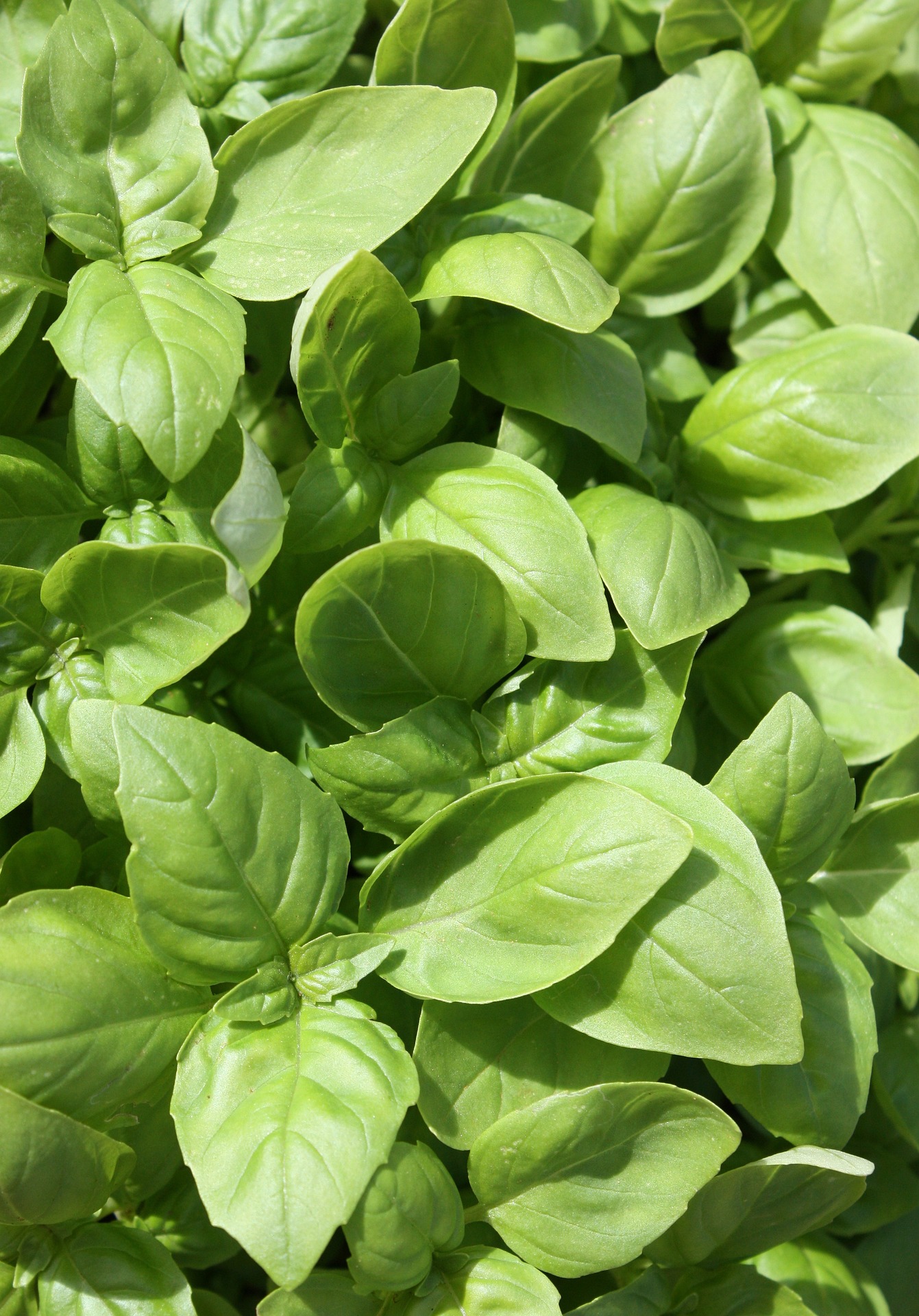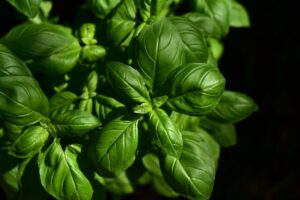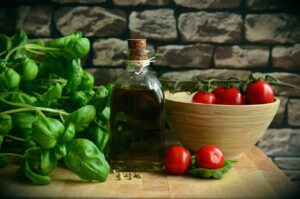Basil
Overview
Basil, or Ocimum basilicum, is an aromatic herb beloved in kitchens around the globe. With roots tracing back to India, this member of the mint family has made a name for itself, particularly within the folds of Italian cuisine. Its glossy, oval-shaped leaves not only lend a fragrant kick to dishes but also offer various flavors, from lemony-mint to licorice-esque twists. Easy to grow and care for, basil continues to be a staple in both culinary and horticultural spaces.

Characteristics
Known for its aromatic leaves, culinary versatility, and easy cultivation as a summer annual herb.
Region
The Basil plant is commonly grown in temperate regions and is native to India and other tropical regions of Asia.
Natural Habitat
Typically found in fields and warm, tropical regions.
Cultivation
Thrives in full sun, prefers well-drained soil, and requires regular watering without overwatering to prevent root rot.
Uses and Benefits
Basil, a beloved herb in many households, is not only a culinary superstar but also a powerhouse of potential health benefits. Its leaves lend a delightful aroma and flavor to a wide array of dishes, from savory pasta sauces to refreshing summer beverages. Pesto, a classic Italian sauce, showcases basil’s versatility and pairs perfectly with everything from pasta to sandwiches and salads.
But basil’s benefits go beyond its culinary prowess. This unassuming herb is packed with essential vitamins and antioxidants that can support your well-being. Research suggests that basil may help reduce oxidative stress in the body, which is linked to various health issues1. Additionally, basil’s unique blend of nutrients may contribute to better cardiovascular health.
Here are some creative ways to incorporate basil into your meals and enjoy its potential benefits:
- Blend fresh basil leaves with olive oil, garlic, pine nuts, and parmesan cheese for a classic pesto sauce
- Muddle basil leaves in lemonade or cocktails for a refreshing twist
- Sprinkle chopped basil over pizzas, pastas, or caprese salads
- Infuse water with basil leaves for a naturally flavored and healthy drink
For those with a green thumb, basil is a fantastic addition to your herb garden. Not only is it easy to grow, but it also has a unique partnership with tomatoes. When planted together, basil is believed to help repel certain pests that might otherwise harm your tomato plants4. This natural pest control method is a win-win for your garden and your kitchen!

Cultivation Tips
To cultivate basil successfully, begin by planting seeds indoors or buying small pots to start your herb garden. When the threat of frost has passed, transition your basil outdoors—choosing a spot that gets plenty of sunshine. Well-drained soil will keep your plant happy; be mindful to water regularly but not excessively, as too much can lead to root problems.
Consider topping your basil plants to encourage a fuller, bushier growth; this practice also extends their productive period. By pruning regularly, you ensure that your basil not only grows well but remains robust and flavorful5. To promote healthy growth and prevent flowering, pinch off the top leaves just above a pair of lower leaves. This encourages the plant to branch out and produce more foliage.
Keep vigilant for pests and diseases, as they can become a challenge, especially if the plant is stressed by overwatering3. Common pests include aphids, whiteflies, and spider mites. If you notice any signs of infestation, take action promptly by removing affected leaves or using a natural insecticide like neem oil.
Basil thrives in warm temperatures, typically between 70-85°F (21-29°C). If you live in a cooler climate, consider using a cloche or row cover to protect your plants from chilly weather. Alternatively, you can grow basil indoors year-round, ensuring a steady supply of fresh herbs for your culinary creations.
Enjoy the beauty and aroma of your basil as it transforms your dishes. Harvest leaves regularly to encourage growth and prevent flowering. With proper care and attention, your basil plants will provide you with an abundant harvest of flavorful, aromatic leaves throughout the growing season.
Seasonal Considerations
To cultivate basil successfully, begin by planting seeds indoors or buying small pots to start your herb garden. When the threat of frost has passed, transition your basil outdoors—choosing a spot that gets plenty of sunshine. Well-drained soil will keep your plant happy; be mindful to water regularly but not excessively, as too much can lead to root problems.
Consider topping your basil plants to encourage a fuller, bushier growth; this practice also extends their productive period. By pruning regularly, you ensure that your basil not only grows well but remains robust and flavorful5. Keep vigilant for pests and diseases, as they can become a challenge, especially if the plant is stressed by overwatering3.
To maximize your basil harvest, follow these seasonal tips:
- Spring: Start seeds indoors 6-8 weeks before the last expected frost. Transplant outdoors when nighttime temperatures consistently stay above 50°F (10°C).
- Summer: Pinch off flower buds to prolong leaf production. Harvest leaves regularly to encourage growth and prevent the plant from going to seed.
- Fall: Before the first frost, harvest remaining leaves and either dry or freeze them for later use.
- Winter: In mild climates, basil may survive outdoors. Otherwise, grow basil indoors near a sunny window, ensuring proper drainage and air circulation.
Enjoy the beauty and aroma of your basil as it transforms your culinary creations throughout the seasons.

Issues and Troubleshooting
Basil, a beloved herb, may encounter a few challenges during its growth. Pests like aphids and spider mites can be attracted to your basil plants. To naturally keep them at bay, consider introducing beneficial predators such as ladybugs to your garden, or use a gentle insecticidal soap.
While water is crucial for basil, overwatering can lead to root rot. This condition can quickly damage your basil plants. To prevent this, make sure your soil has good drainage and stick to a consistent watering schedule that allows the soil to dry out slightly between waterings3. Watch for yellowing or dropping leaves, which can indicate improper watering.
Basil thrives in sunlight, requiring at least six hours of direct sun to maintain lush leaves and peak flavor2. If your basil isn’t receiving enough sunlight, consider relocating it to a brighter spot or using grow lights for indoor cultivation.
Other potential issues and solutions include:
- Fungal diseases: Improve air circulation around plants and avoid getting water on the leaves.
- Nutrient deficiencies: Feed your basil with a balanced, organic fertilizer every few weeks during the growing season.
- Bolting (premature flowering): Pinch off flower buds as they appear to encourage leaf production and delay bolting.
By staying attentive to your basil’s needs and addressing issues promptly, you can enjoy a bountiful harvest of this flavorful herb.
History and Folklore
Steeped in a rich tapestry of history and folklore, Basil (Ocimum basilicum) has captivated cultures across the globe for centuries. This aromatic herb, native to the sun-drenched soils of India, embarked on a journey that would forever etch its name in the annals of culinary and spiritual traditions.
As basil voyaged across continents, it found a particular affinity with the people of Italy, who embraced its vibrant flavor and wove it into the very fabric of their cuisine. Meanwhile, in its homeland of India, basil assumed a sacred role in Hindu tradition, often accompanying the deceased on their final journey as a symbol of protection and reverence4.
Yet, not all cultures viewed basil through the same lens. The ancient Greeks, for instance, regarded this herb with a mix of caution and superstition, associating it with misfortune and ill omens. However, it was in the humble kitchen gardens where basil truly showcased its prowess, with many believing in its ability to ward off pests through its potent scent1.
As basil continued to traverse the world, it left an indelible mark on the cultures it encountered, its legacy forever intertwined with tales of love, prosperity, and mystery. Today, this herb remains an essential component in countless dishes, a testament to its enduring allure and the rich history that has shaped its journey through time.
References
1. Britannica, “Basil | Definition, Plant, Uses, Species, & Facts,” https://www.britannica.com/plant/basil
2. Martha Stewart, “How to Plant, Grow, and Care for Basil Plants,” https://www.marthastewart.com/8077660/basil-plant-guide
3. Better Homes & Gardens, “How to Plant and Grow Basil,” https://www.bhg.com/gardening/plant-dictionary/herb/basil/
4. The Spruce, “How to Grow Basil,” https://www.thespruce.com/how-to-grow-basil-plants-1402624
5. The Old Farmer’s Almanac, “Basil: How to Plant, Grow, and Harvest Basil,” https://www.almanac.com/plant/basil
Image Credit: kerdkanno
Image Credit: ulleo
Image Credit: congerdesign
Nicolas Duval
Nicolas is a passionate advocate for nature and the art of wildcrafting. His dedication shines through in Wildcraftia, a website he meticulously crafted to serve as a haven for nature enthusiasts worldwide. Driven by a deep appreciation for nature’s connection to humanity, Nicolas embarked on his journey in 2011 with SmokableHerbs, a platform showcasing his love for nature’s bounty. Building upon this foundation, he established Smokably, a thriving online store offering premium herbs and blends to a global audience.
